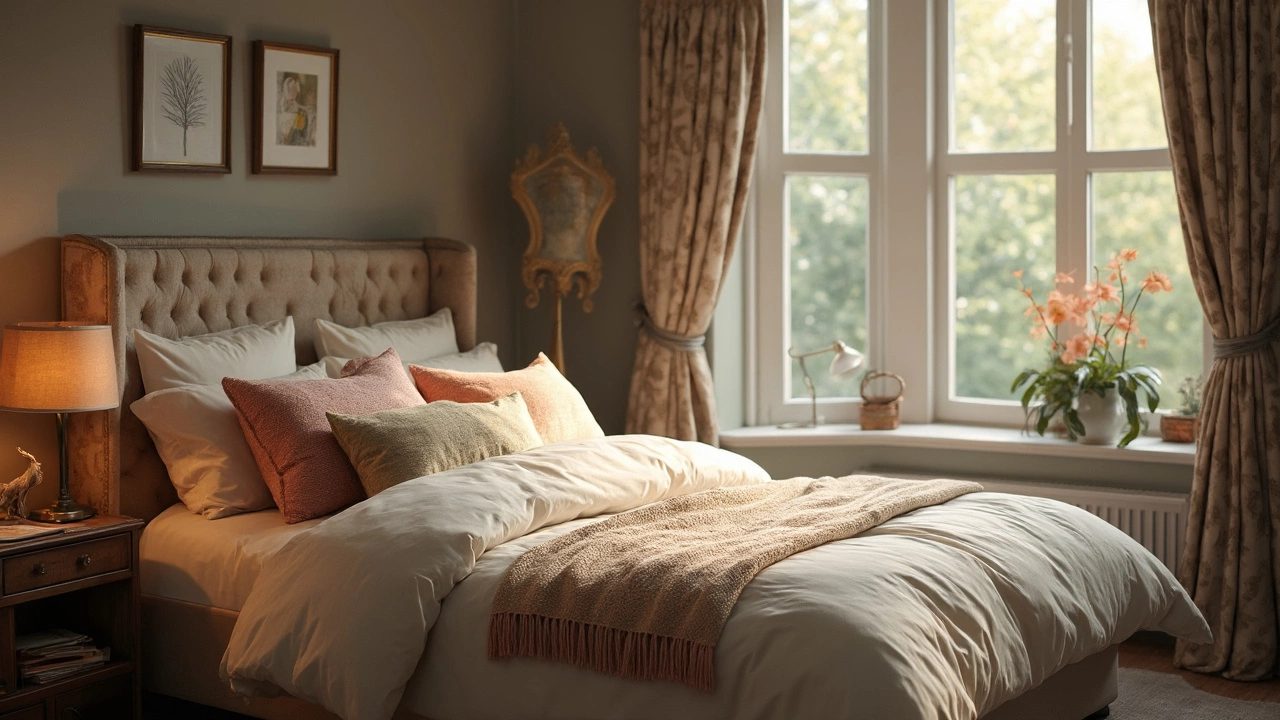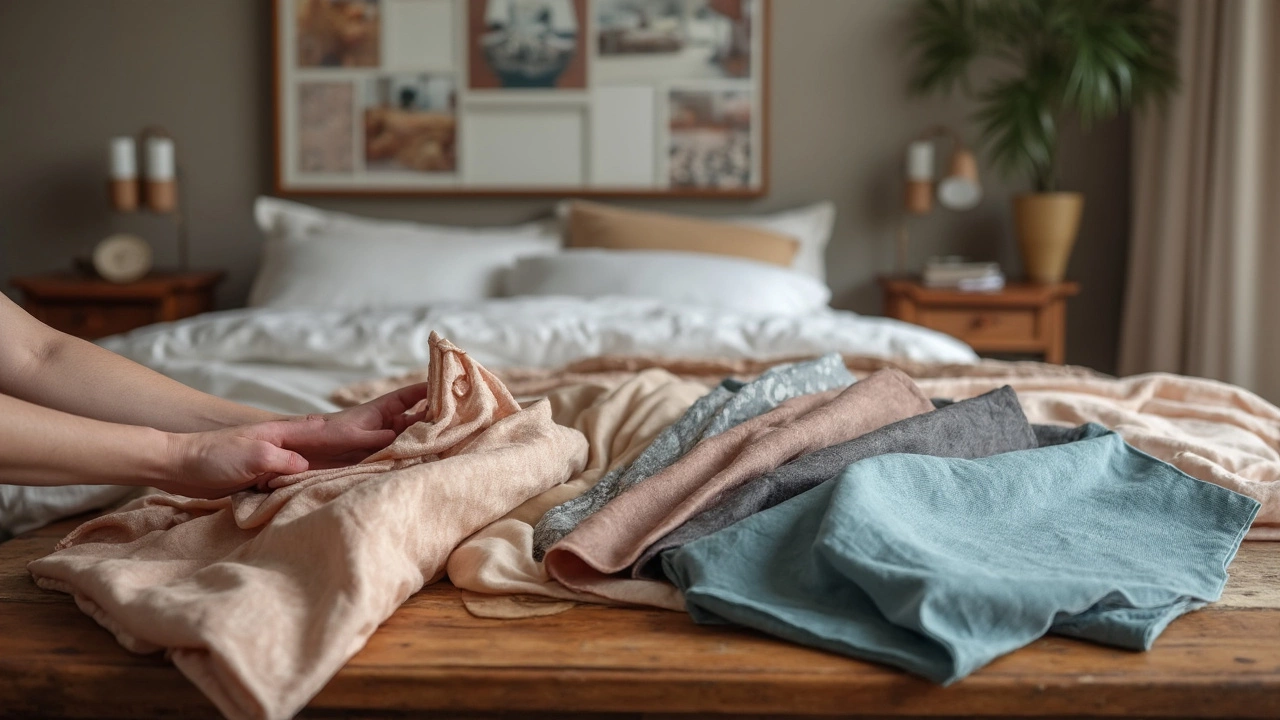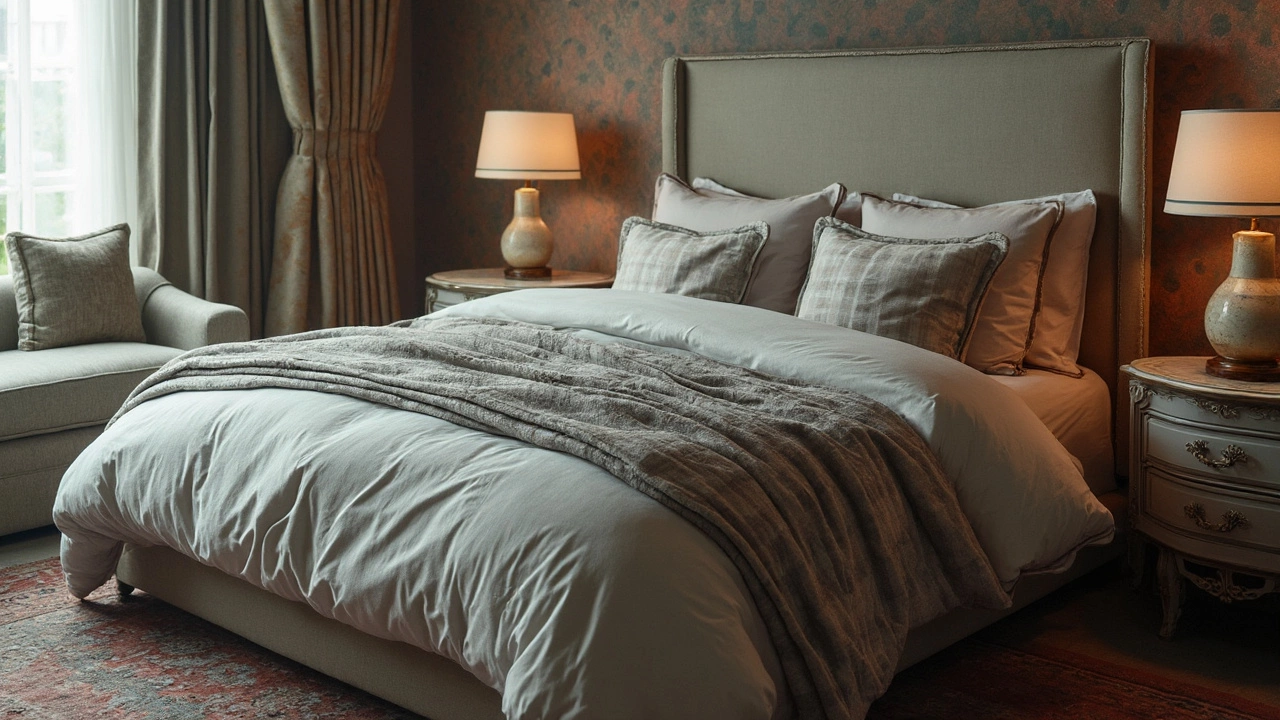Full Bedding Explained: What You Need to Know

Ever wonder what 'full bedding' actually means? You’re not alone. Full bedding is a term that throws some folks off, but it's really just talking about the stuff that fits on a full-sized or double bed. It's all about getting those linens and covers just right for your space.
So, what's the deal with full-size? It usually means a mattress that's about 54 inches wide and 75 inches long. Why does size matter? Because it helps you pick out sheets and comforters that fit snugly and comfortably.
Now, let's not forget the basics. Getting the right-sized sheets, blankets, and pillowcases is key to not waking up tangled in a mess. For a good night’s rest, it’s worth investing time in knowing what goes with your full bed.
Materials make a big difference too. From cozy cotton to sleek satin, your choice can adjust bedroom vibes and your nighttime comfort. So, next time you’re in the market for bedding, keep these points in mind, and your sleep space will be in top shape.
- Understanding Full Size Dimensions
- Essential Elements of Full Bedding
- Choosing the Right Materials
- Tips for a Perfect Fit
- Common Full Bedding Mistakes to Avoid
Understanding Full Size Dimensions
Let's dig into the nuts and bolts of full-size bedding. Knowing these dimensions can be a game-changer for picking the right full bedding for your bedroom.
Exact Measurements
A full-size bed, often called a double bed, typically measures around 54 inches in width and 75 inches in length. This size gives single sleepers ample space to stretch out without hogging too much room. Though not as roomy as a queen or as compact as a twin, the full size strikes a nice balance, especially for teenagers and single adults.
Why Size Matters
The dimensions are crucial because they help you find the perfect fit for sheets and covers. Too big, and you're lost in excess fabric; too small, and you’ll be fighting to get them on. Knowing you have a full-size bed guides you to buy bedding labeled specifically for those dimensions.
Benefits of Full Size
A full bed offers more flexibility. It’s wide enough for some couples, though a bit snug, and is a great middle-ground option for guest rooms.
- Good for small rooms: Fits well in tight spaces where larger beds might feel cramped.
- Budget-friendly: Often cheaper than queen or king-size options, both for the bed frame and bedding.
- Versatile style: Works well with different decor styles, adding flexibility to design choices.
Next time you're shopping for bedding, remember these dimensions to ensure you’re getting everything just right. It's all about that perfect night’s sleep without any fuss.
Essential Elements of Full Bedding
When it comes to full bedding, knowing the different parts of what you actually need is half the battle. Let’s break it down so you can make your bed more than just a place to sleep—it can be a mini haven.
1. Sheets
First up, the sheets. You're going to need a fitted sheet designed for a full-size bed. It’s usually about 54 inches wide and 75 inches long. Then there's the flat sheet—some people use it, some don’t, but it gives that extra layer of comfort and can protect your duvet or comforter.
2. Pillows and Pillowcases
Pillows are pretty personal. For a full bed, a pair of standard pillows usually does the trick, but you might want more if you love tossing and turning. Remember to grab pillowcases that are not just the right size, but also the right material—cotton for breathability or satin for a bit of luxury.
3. Comforters, Duvets, or Quilts
Here’s where style and warmth come together. Full-size comforters should be around 86 by 86 inches, but always check measurements because they can vary. If you go with a duvet, you’ll need a duvet cover too, which you can swap out to change looks easily.
4. Mattress Protectors or Toppers
Don’t skip the mattress protector! Whether it’s for allergy reasons or just to keep things clean, it’s an essential part of your full bedding setup. Toppers can also help with firmness if your mattress isn’t quite right.
5. Bed Skirts or Dust Ruffles
Not everyone uses a bed skirt, but they’re handy to hide stuff you might store under the bed. Plus, they can add a splash of style to your bedroom set-up.
Putting It All Together
Combine these components, and your full bed can transform into a perfect retreat. Remember, material matters, so always look for what suits your comfort best, and keep an eye on washing instructions to make them last longer.
Quick Overview
| Element | Standard Dimensions | Purpose |
|---|---|---|
| Fitted Sheet | 54 x 75 inches | Covers the mattress |
| Flat Sheet | Varies | Added comfort layer |
| Comforter | 86 x 86 inches | Warmth & style |
Understanding each component’s role helps you make more informed purchases the next time you're upgrading your full bedding. Whether you're a sheet perfectionist or a duvet aficionado, having the right elements makes all the difference.

Choosing the Right Materials
When it comes to dressing your full-size bed, the right materials can make all the difference. It's not just about style; it's really about how comfy and cozy you want to be.
The Best Fabrics for Sheets
When choosing sheets for your full bedding, think about what feels good against your skin. Cotton is a popular choice because it's breathable and keeps you cool. If you're into that soft, luxurious feel, Egyptian cotton is top-notch. It’s a bit pricier, but it lasts longer. For those chilly environments, flannel is a warm alternative.
Considering a little shine? Satin sheets are known for their sleekness, but they can be slippery, which isn't everyone's cup of tea. Also, keep an eye out for the thread count. A sweet spot for comfort and durability is around 300 to 500.
Choosing Comforters and Duvets
Your comforter choice is just as crucial. Down comforters provide warmth without much weight and are perfect if you prioritize fluffiness. Just make sure you’re not allergic! Down alternatives are a great pick for allergen-free zoners.
Cover materials matter too. Cotton and cotton blends are common because of their durability and breathability. Microfiber tends to be softer, but it can trap heat, so consider if you're a hot sleeper.
Pillows Matter
Don’t overlook the pillows. The fill determines firmness, and you’ve got choices: down, feather, memory foam, or synthetic. Down and feather give that classic plush feel, memory foam molds to your head, and synthetic is usually more budget-friendly.
Tip: Match and Layer
Remember, variety is your friend when building full bedding that suits all seasons. Having a couple of layer options means you can strip back to cooler sheets in summer and double up for winter warmth.
Interesting Fact
Did you know the bedding industry in the U.S. grew by 5% annually as consumers invested more in comfort? This trend highlights how many folks prioritize quality sleep these days.
Tips for a Perfect Fit
Getting that sweet spot for your full bedding is less tricky with some simple tips. First up, measure your mattress. Seems basic, right? But you'd be surprised how many people skip this step. Knowing those bed sizes pays off when you're buying sheets and covers.
Prioritize Fitted Sheets
Let's talk fitted sheets. They're the unsung heroes of the bed world. A good rule of thumb is to ensure they have deep pockets, around 14 to 16 inches if you’ve got a thicker mattress. Because nobody wants to wrestle with sheets that keep slipping off.
Choosing the Right Comforter
The comforter is another key player. You'll want one that drapes nicely, falling just over the bed’s edges. It's a touch of coziness that doesn’t go unnoticed. If you fancy a bit of extra warmth, maybe go for a down or down-alternative option.
Look for Quality Materials
Quality speaks volumes when it comes to long-lasting comfort. According to Michael Chase, a bedding specialist at Sleep Well Labs, “Investing in cotton or linen can significantly improve your sleeping experience.” These materials breathe well, making them a classic choice for most seasons.
Mattress Size Guide
| Mattress Type | Width | Length |
|---|---|---|
| Twin | 38 inches | 75 inches |
| Full | 54 inches | 75 inches |
| Queen | 60 inches | 80 inches |
| King | 76 inches | 80 inches |
Keep Comfort and Aesthetics in Balance
Lastly, balance comfort with aesthetics. A chic bed layout often starts with a solid foundation of simple, well-fitted sheets and builds up with decorative throws or pillows. Just remember, it’s okay to start simple and add more flair as you go.

Common Full Bedding Mistakes to Avoid
We’ve all been there—buying the perfect bedding set only to find out it just doesn’t fit right. No worries, though, because avoiding these common pitfalls with full bedding can save you a lot of hassle.
Getting the Size Wrong
It might seem like a no-brainer, but one of the biggest slips is confusing bed sizes. A full size mattress is not a queen or a twin, so double-check those dimensions. Using sheets that are too small can leave you fighting to get them on, while oversized ones create that dreaded bunch-up situation.
Overlooking Material Preferences
Material matters. Whether you're after the softness of cotton or the elegance of satin, not thinking about fabric can lead to uncomfortable nights. Breathability, ease of care, and even how the fabric feels against your skin after a wash should be on your mind when picking out your full bedding.
Skipping the Wash
Always wash new bedding before use. Think of it this way: fresh from the package might look fab, but a quick wash removes potential irritants from the production process and helps soften stiff fabrics.
Ignoring Color and Décor
Your bedding should vibe with your room’s décor. Choosing colors or patterns without considering the big picture can lead to a mismatched look. And while personal style is key, a little harmony goes a long way.
Neglecting Pillow and Comforter Sizes
We often focus on the sheets and forget that our pillows and comforters deserve attention too. Standard-sized pillowcases may not always fit larger decorative pillows. Similarly, a too-small comforter on a full bed can leave your feet hanging out in the cold.
Avoid these stumbling blocks, and you’ll not only enhance the comfort of your bed but also its look. Remember, your full bed is more than just a place to sleep—it’s the centerpiece of your room.